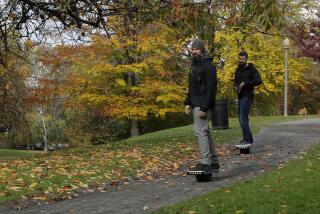Warning: Scooters and other toys may be hazardous to a child’s health

- Share via
What products force kids to seek treatment in U.S. emergency rooms at the rate of one every three minutes? A new study has a surprising answer: toys.
Toy-related injuries involving American children have jumped about 40% since 1990, according to an analysis from the Center for Injury Research and Policy at Nationwide Children’s Hospital in Columbus, Ohio.
In 1990, infants, toddlers, kids and teens were being injured at a rate of 18.9 per 10,000 people under the age of 18. By 2011, that rate had jumped to 26.4 per 10,000.
The total number of toy-related injuries grew even more during that period, from 121,249 in 1990 to 195,363 in 2011. That’s an increase of 61%, the researchers reported this week in the journal Clinical Pediatrics.
Many of these injuries could have been prevented if toys were designed with a greater emphasis on safety, they added.
These estimates are based on data from the National Electronic Injury Surveillance System, which is run by the federal Consumer Product Safety Commission. The commission collects patient data from a nationally representative sample of about 100 hospitals that have 24-hour emergency rooms and at least six inpatient beds. This data are used to calculate injuries for the entire country.
With about 3 billion model planes, hula hoops, building block sets and other toys sold in the U.S. every year, “the importance of toys in society cannot be underestimated,” the researchers wrote. Most of the time, kids emerge unscathed from their play sessions.
But not always.
When it came to injuries involving toys, the researchers found:
-- The age at which children were most likely to be injured was 2, and kids younger than 5 accounted for just over half (50.5%) of the total injuries.
-- Four out of 5 injuries were sustained at home, and 63% of the mishaps involved boys.
-- Toy-related injuries were more frequent during the spring and summer months of April through September (57%) than during the fall and winter months of October through March (43%).
-- The overwhelming majority (98%) of kids seen in emergency rooms were released without being admitted to the hospital.
One type of toy was called out for its role in fueling the rise of injuries: foot-powered scooters. The total number of injuries involving these and other “ride-on toys” shot up 74% during the study period, from 41,418 in 1990 to 71,929 in 2011, the researchers found. This category was responsible for 35% of all toy-related injuries, more than any other specific toy product.
Scooters helped make falls and collisions the most common types of toy-related injuries, accounting for 46% and 22% of the total, respectively. Put another way, 60% of falls were the result of playing with ride-on toys.
Accidents related to scooters tended to be more severe than other toy-related injuries, according to the report. For instance, kids playing with ride-on toys were 3.2 times more likely to sustain a fracture or dislocation compared with kids using other kinds of toys. Overall, fractures and dislocations accounted for 11% of all toy-related injuries, coming in third behind lacerations (39%) and soft tissue injuries (21%).
Finally, kids who went to ERs after hurting themselves on ride-on toys were 38% more likely than other kids to be admitted to the hospital, the researchers found. In all, 43% of toy-related hospital admissions during the study period were due to mishaps with ride-on toys.
“Foot-powered scooters gained popularity at the turn of the millennium and were soon associated with a rapid rise in both fatal and nonfatal injuries,” the researchers wrote. Though the injury rate for these toys declined somewhat after the initial spike, it has been rising again since 2005. “An amplification of prevention efforts is needed to prevent further loss of earlier public health gains,” they wrote.
For better living through science, follow me on Twitter @LATkarenkaplan and “like” Los Angeles Times Science & Health on Facebook.







